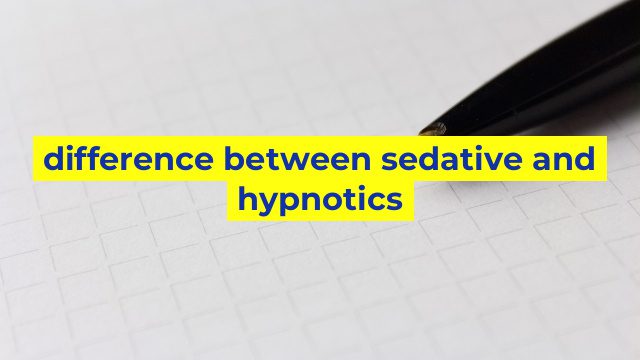Differentiating Between Sedatives and Hypnotics
When it comes to managing anxiety and sleeping disorders, sedatives and hypnotics are the two most common types of medication prescribed by healthcare professionals. Both medications have similar functions, but they differ in their method of action and duration of efficacy. In this article, we will discuss the differences between sedatives and hypnotics, their functions, and their side effects.
What Are Sedatives?
Sedatives are medications that work by depressing the central nervous system, causing the brain to slow down its activity level. Sedatives are usually prescribed to patients with moderate to severe anxiety disorders, panic attacks, or those undergoing invasive medical procedures. Sedatives such as benzodiazepines, barbiturates, and alpha agonists are commonly used.
What Are Hypnotics?
Hypnotics, on the other hand, are medications that are specifically used to promote sleep. Hypnotics are similar to sedatives, but they are stronger and more selective in their effect on the brain. Unlike sedatives, hypnotics are used for short-term sleep problems and are not recommended for long-term use due to the risk of dependence. Common hypnotics include zolpidem, eszopiclone, and zaleplon.
Differences in Mechanism of Action
The primary difference between sedatives and hypnotics is their mechanism of action. Sedatives work by suppressing the activity of the central nervous system, whereas hypnotics target specific areas in the brain that induce sleep. Sedatives are commonly used to manage stress and anxiety disorders, while hypnotics are prescribed for insomnia.
Durations of Efficacy
Another significant difference is the duration of efficacy between sedatives and hypnotics. Sedatives have a longer onset time, with effects usually taking 30 minutes to an hour before the medication starts to take effect. The effects of sedatives tend to last longer than hypnotics, with some lasting up to 12 hours. Hypnotics, on the other hand, have a shorter onset time, with effects usually taking effect within 15 to 30 minutes. The effects of hypnotics usually last for 4 to 6 hours.
Side Effects
Both sedatives and hypnotics share similar side effects, including drowsiness, dizziness, and impaired coordination. Sedatives also have side effects like muscle weakness, respiratory depression, and memory impairment. Hypnotics can cause nausea, headaches, and unpleasant taste in the mouth. Both types of medication can also lead to dependence and addiction if used long-term.
Conclusion
In conclusion, sedatives and hypnotics are both used to manage anxiety and sleep disorders, but they differ in their mechanism of action, duration of efficacy, and side effects. While both medications can be highly effective, patients should consult their healthcare professionals before using any medication to understand the risks and benefits, as well as the potential side effects.
Table difference between sedative and hypnotics
Sedatives vs Hypnotics
| Sedatives | Hypnotics | |
|---|---|---|
| Definition | Drugs that are used to calm and relax a person or to induce sleepiness. | Drugs that are primarily used to induce sleep. |
| Effects on the Body | Reduce anxiety, muscle tension, irritability, and excitement. Can also cause drowsiness, slow breathing, and decreased blood pressure. | Induce sleep, but may also cause drowsiness, slow breathing, and decreased blood pressure. |
| Usage | Used to treat anxiety, insomnia, and in some cases, seizures. | Used to treat severe and persistent insomnia. |
| Addiction Potential | May have a lower risk of addiction compared to hypnotics. However, long-term use can lead to dependence and withdrawal symptoms. | May have a higher risk of addiction, especially if used for an extended period of time. Can also cause withdrawal symptoms. |
| Examples | Benzodiazepines, barbiturates, and antihistamines. | Zolpidem (Ambien), eszopiclone (Lunesta), and temazepam (Restoril). |


